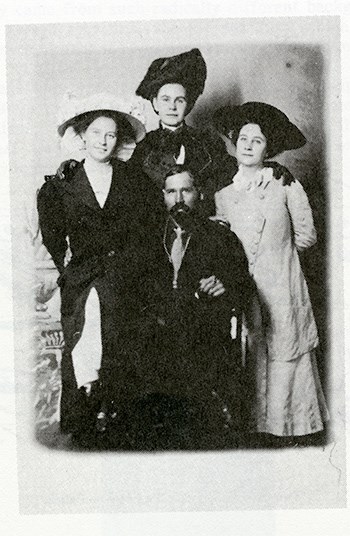Part of a series of articles titled Women's History in the Pacific West - Lower Colorado Basin Collection.
Previous: Mary Beal
Next: Alice Ballard
Article

Courtesy of the National Park Service.
Frances Lawton Keys was part of a wave of Anglo pioneers who came to the arid Southern California desert in the late nineteenth and early twentieth centuries, patching together a variety of ventures on public domain land. Her labors at the Desert Queen Ranch in Joshua Tree, encompassing mining and cattle ranching as well as butchering, canning, sewing, teaching, providing her family and livestock with medical care, and selling homemade items to an emerging tourist clientele, demonstrate the diverse economic contributions of women in the West. One such venture was the sale of head coverings: conscious of protecting her fair complexion from the harsh desert sun and wind, Keys constructed her own bonnets, and eventually developed a clientele among the women living in the nearby communities of Twentynine Palms and the Yucca Valley.1
Frances Mae Lawton was born in 1887 in Lucas County, Ohio to Wallace R. Lawton and Lena H. Weeks. After a few years in Canada, her family moved to California, where she found work as a stenographer.2 In Los Angeles, she met Bill Keys, a prospector, miner, and adventurer. They married in 1918, one year after he filed for a homestead in Joshua Tree, determined to become a rancher. The home they built on the land previously owned by the Desert Queen Mine received many of its aesthetic improvements from Keys, who wallpapered and whitewashed the walls.3
Family life at the Desert Queen was hard work. The Keys family had seven children, of whom three died in childhood, including twelve-year-old son Ellsworth, who died as a result of an accident operating the family’s well.4 The oral history of son Willis Keys provides many of the details that we know about day-to-day life at the Desert Queen. The family raised goats, chickens, and cattle, and grew a wide variety of vegetables, including radishes, cucumbers, tomatoes, pumpkins, squash, corn and beans.5 Keys trained her children to assist her in the daily rounds of collecting eggs and milking the goats. She made harvests last through the winter with extensive canning and preserving. She butchered animals for meat, and she cooked all of the family meals on a wood stove. Only in the last few years of her life did she have the relative luxury of propane.6
The geographic isolation of the ranch pressed additional duties onto Keys as the family doctor and school teacher.7 She instructed her children in a schoolhouse built by her husband until 1932, when a teacher from a town nearby began to instruct the Keys children and a few others from the Yucca Valley.8 Though the Desert Queen Ranch itself was isolated, Keys helped the family maintain connections to other desert dwellers. She sold surplus canned goods, produce, and her bonnets at the market in the Yucca Valley.9 She also sold items to residents in the city of Twentynine Palms, where many visitors to the Joshua Tree National Park now enter the park.10 She was a fierce protector of her family and property, and was liable to greet visitors to the family compound with a pistol on her hip.11
As desert homesteaders, the Keyses endured their fair share of claim and boundary disputes. In 1943, Bill Keys shot and killed Worth Bagley, in what Keys maintained was an act of self-defense. He was charged with murder and sent to San Quentin State Prison in Northern California. Frances Keys and her younger children lived alone on the ranch for a time before moving to Alhambra, California, where her son Willis had moved for work after high school.12 Bill Keys was paroled in 1948, and the couple resumed living together at the Desert Queen; in 1958 he received a pardon from the governor.13
Frances Lawton Keys had a hobby of collecting artifacts found around the old gold mines, especially any colored glass such as pharmacy or tobacco bottles, which she displayed at home.14 She died in 1963 and is buried on the private family plot next to the children who predeceased her and her husband Bill, who died seven years later. Her grave is marked by a headstone Bill cut by hand from native stone. After her death, her husband sold their mine and ranch; in 1974 the ranch was designated a National Park Service Historic Site.15
Part of a series of articles titled Women's History in the Pacific West - Lower Colorado Basin Collection.
Previous: Mary Beal
Next: Alice Ballard
Last updated: February 15, 2023